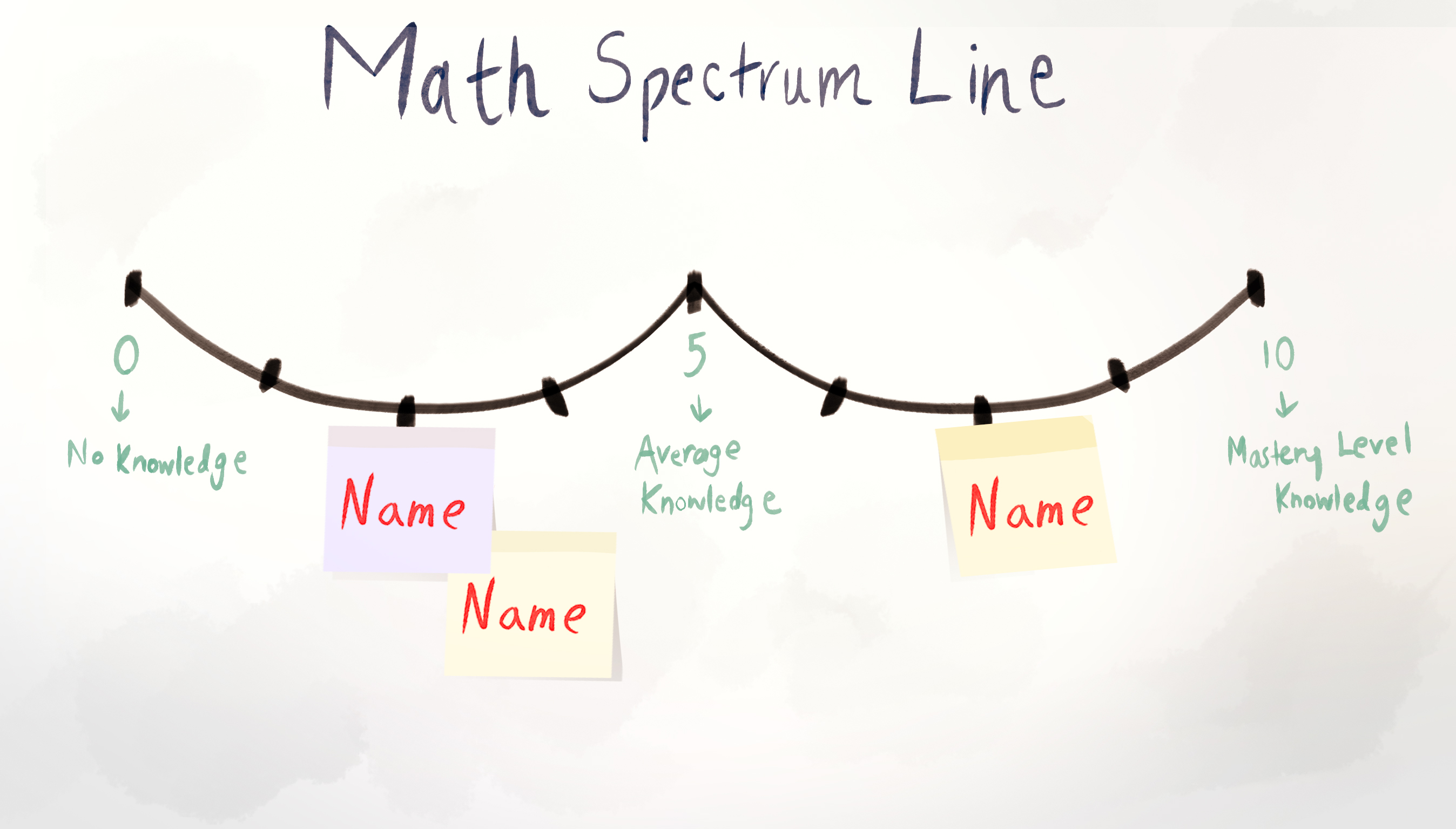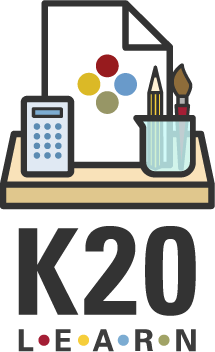Summary
This activity focuses on eliminating the emotional fear of mathematics by allowing students to evaluate where they are on the math spectrum and identify their goals moving forward. This is a great activity to do not only in the first days of school but also to revisit multiple times a year. The Extend phase can serve as a repeat reflection tool to help students see their mathematical and emotional progress throughout the school year. By allowing students to understand their emotional relationship with mathematics, set goals, and identify barriers, this learning experience fosters a growth mindset moving forward.
Essential Questions
What is the relationship between students’ mathematical knowledge and their perception of mathematics?
How can this perception be used to develop a growth mindset?
Objectives
Analyze feelings toward math.
Create a plan to find success in math class.
Snapshot
Engage
Students reflect on a video and place their initial self-assessment of their math knowledge on a spectrum line.
Explore
Students research mathematical concepts learned in previous courses to expand their knowledge on the topic.
Explain
Students present their findings to a peer.
Extend
Students create a plan to promote individual growth and success in the math classroom for the coming school year.
Evaluate
Students assess their newfound relationship with math through an Exit Ticket.
Materials List
Activity Slides (attached)
Note Catcher handout (attached; one per student; print one-sided)
Math Concepts handout (attached; one per student; print one-sided)
Math Goals handout (attached; one per student; print two-sided)
Exit Ticket handout (attached; optional)
Spectrum Line Materials: tape and string or whiteboard (see Preparation section for options)
Sticky notes (one per student)
Student devices with internet access
Preparation
Prior to the activity, create a “math spectrum line” for use during the Engage phase. Label the left end with “No Knowledge” and the right end with “Mastery Level Knowledge.” Make sure the line is long enough for a whole class of students to each add a sticky note along the line. There will likely be stacking or overlapping of sticky notes, which is okay. To create the math spectrum line, you could:
Use whiteboard space to draw a math spectrum line so students can stick their sticky note to the whiteboard.
Hang string on the wall (or whiteboard) and use tape or clothes pins to attach sticky notes (or index cards) to the string.
Use a tech tool such as Canva to create a math spectrum line so students can add digital sticky notes.

During the Engage phase, students will place a sticky note with their name where they think they belong.
Engage
10 Minute(s)
Introduce the activity using the attached Activity Slides. Share the essential questions on slide 3 and the learning objectives on slide 4. Review each of these with your class to the extent you feel necessary.
Distribute a copy of the attached Note Catcher handout to each student and then show the With Math I Can video found on slide 5.
Give students a couple minutes to reflect on the video. Ask them to write down a takeaway they got from the video. The cloud on the handout will be a place for them to write down thoughts they have throughout the learning experience.
After students have written their takeaway on their handout, transition to slide 6. Have students discuss their takeaway with an Elbow Partner. Have students use the prompts on the slide to guide their discussions.
What did you like about the video?
What did you not like about the video?
What one takeaway really caught your attention?
Display slide 7 and ask students: “How much math do you know?” If your math spectrum line is physically on display in your classroom, instruct students to take a sticky note, write their name on it, and place it where they believe they lie on the math spectrum that you have created for the class. If you choose to make your math spectrum line on an interactive whiteboard, instruct the students to write their names on the line. Use the graphic on the slide to help communicate to students that the far left side represents having zero knowledge and the far right side is a master at the subject.
Explore
15 Minute(s)
After students have analyzed where they are on the math spectrum, show slide 8. Direct students’ attention to the “Brain Dump” section of their Note Catcher handout. Have them use a modified Collective Brain Dump and list every math concept they can remember learning.
Once they have written down a list of math concepts, move to slide 9. Have students select two concepts to start exploring online. Distribute the attached Math Concepts handout to each student. Introduce the Stop and Jot strategy to guide students in taking key notes while they are researching their topics. Have students read through different resources, stop to process the information, and then jot down any key terms on their handout. Inform students that they will be explaining the topics they research to another student, so it is important to take good notes.
Explain
15 Minute(s)
Display slide 10 and ask students to find a partner who did not research the same math concepts they did. Allow about 5 minutes for partners to share their findings. As they present, each student should explain the math concepts they researched. Instruct students to take notes on their partner’s explanation in the space provided on the Math Concepts handout.
After both students have shared, move to slide 11. Ask students to use the space at the bottom of the handout to write one summary statement that explains a connection between one of their concepts and one of their partner’s. Invite students to share their summary statements with the class.
Extend
20 Minute(s)
After each pair shares their summary statement, display slide 12 and ask, “How much math do you know NOW?” Invite students to reevaluate their position on the classroom math spectrum and move their name if they feel it is appropriate. After hearing various math concept presentations, many students may shift their name to the right—toward mastery.
Once students have adjusted their position, continue reinforcing a growth mindset by introducing the next activity: creating a math plan for the school year. Display slide 13 and distribute the attached Math Goals handout. Ask students to reflect on past successes and challenges with math, then record those reflections on the front of the handout.
Show slide 14. Direct students’ attention to the back of the handout and introduce the concept of SMART Goals. Have students write three math-related goals for the year. Emphasize that this step helps students develop a personal vision for their learning journey.
Once students have completed their math plans, display slide 15 and ask students to take out a piece of notebook paper. Invite students to reflect on potential obstacles to their success in math by identifying barriers they may face this year, as well as barriers that may have impacted their math performance in the past. Ask students to record at least one barrier on their paper. If they feel comfortable, invite a few volunteers to share their responses with the class.
Once everyone who wishes to do so has shared, transition to slide 16. Invite the students to raise their notebook paper (on which they have written their barriers), rip it up, and toss the remains in the trash. This will symbolize that their past barriers can no longer hinder their future.
Evaluate
5 Minute(s)
To end the activity in reflection, have the students complete an Exit Ticket on a piece of paper or on the attached Exit Ticket handout. Display slide 17 and have students respond to the prompts listed:
What did you learn about your relationship with math today?
This year in math will be a success if…
Research Rationale
Research suggests that a growth mindset supports student achievement and success beyond high school. When an individual has a growth mindset, they are not as timid to take on challenges and not set back by their failures on the way toward success. Motivation increases because achievement is not only tied to an immediate outcome, but also to the process of learning or growing.
Some research shows that students who were taught malleable intelligence had a clear increase in math grades (Yeager et al, 2016). Teacher mindset also has a big impact on student mindset (Boaler 2020; Dweck, 2007). Mindset has been linked to academic achievement (and by extension, college preparedness) in that students with a growth mindset are more willing to take on new challenges and not give up as soon as they experience failure.
Yeager and colleagues (2016) reported results in a very large study (N = 3676) of students transitioning to high school. A revised growth mindset intervention was given online during two class periods at the beginning of the fall semester. Semester GPA was better for students in the experimental group than in the control group, but only for those who entered high school as low achievers (based on 8th grade GPA). The growth mindset intervention also meant reduced rates of poor performance for low, but not high, achievers. However, although high achievers in the experimental group did not see an improvement in grades, they did exhibit more hypothetical challenge-seeking behavior compared to the control, suggesting that growth mindset interventions can encourage challenge-seeking in high achievers whereas it improves academic performance in low-achievers.
Resources
Boaler, J. (2020). Limitless mind: Learn, lead, and live without barriers. New York: HarperCollins.
Dweck, C. S. (2007). Mindset: The new psychology of success. New York: Random House.
K20 Center. (n.d.). Academic achievement through growth mindset interventions: Insights from a national multisite study. University of Oklahoma. https://learn.k20center.ou.edu/literature-review/4904
K20 Center. (n.d.). Bell ringers and exit tickets. Strategies. https://learn.k20center.ou.edu/strategy/125
K20 Center. (n.d.). Canva. Tech Tools. https://learn.k20center.ou.edu/tech-tool/612
K20 Center. (n.d.). Collective brain dump. Strategies. https://learn.k20center.ou.edu/strategy/111
K20 Center. (n.d.). Elbow Partners. Strategies. https://learn.k20center.ou.edu/strategy/116
K20 Center. (n.d.). Google classroom. Tech Tools. https://learn.k20center.ou.edu/tech-tool/628
K20 Center. (n.d.). Google docs. Tech Tools. https://learn.k20center.ou.edu/tech-tool/2327
K20 Center. (n.d.). Google forms. Tech Tools. https://learn.k20center.ou.edu/tech-tool/2341
K20 Center. (n.d.). Padlet. Tech Tools. https://learn.k20center.ou.edu/tech-tool/1077
K20 Center. (n.d.). SMART goals. Strategies. https://learn.k20center.ou.edu/strategy/4250
K20 Center. (n.d.). Stop and Jot. Strategies. https://learn.k20center.ou.edu/strategy/168
With Math I Can. (2016, February 2). With math I can. [Video]. YouTube. https://www.youtube.com/watch?v=sLPFaOvhlKw
Yeager, D. S., Romero, C., Paunesku, D., Hulleman, S., Schneider, B., Hinojosa, C., Lee, H. Y., O’Brien, J., Flint, K., Roberts, A., Trott, J., Greene, D., Walton, G. M.,& Dweck, C. S. (2016). Using design thinking to improve psychological interventions: The case of the growth mindset during the transition to high school. Journal of Educational Psychology, 108, 374-391.Doi: 10.1037/edu0000098


